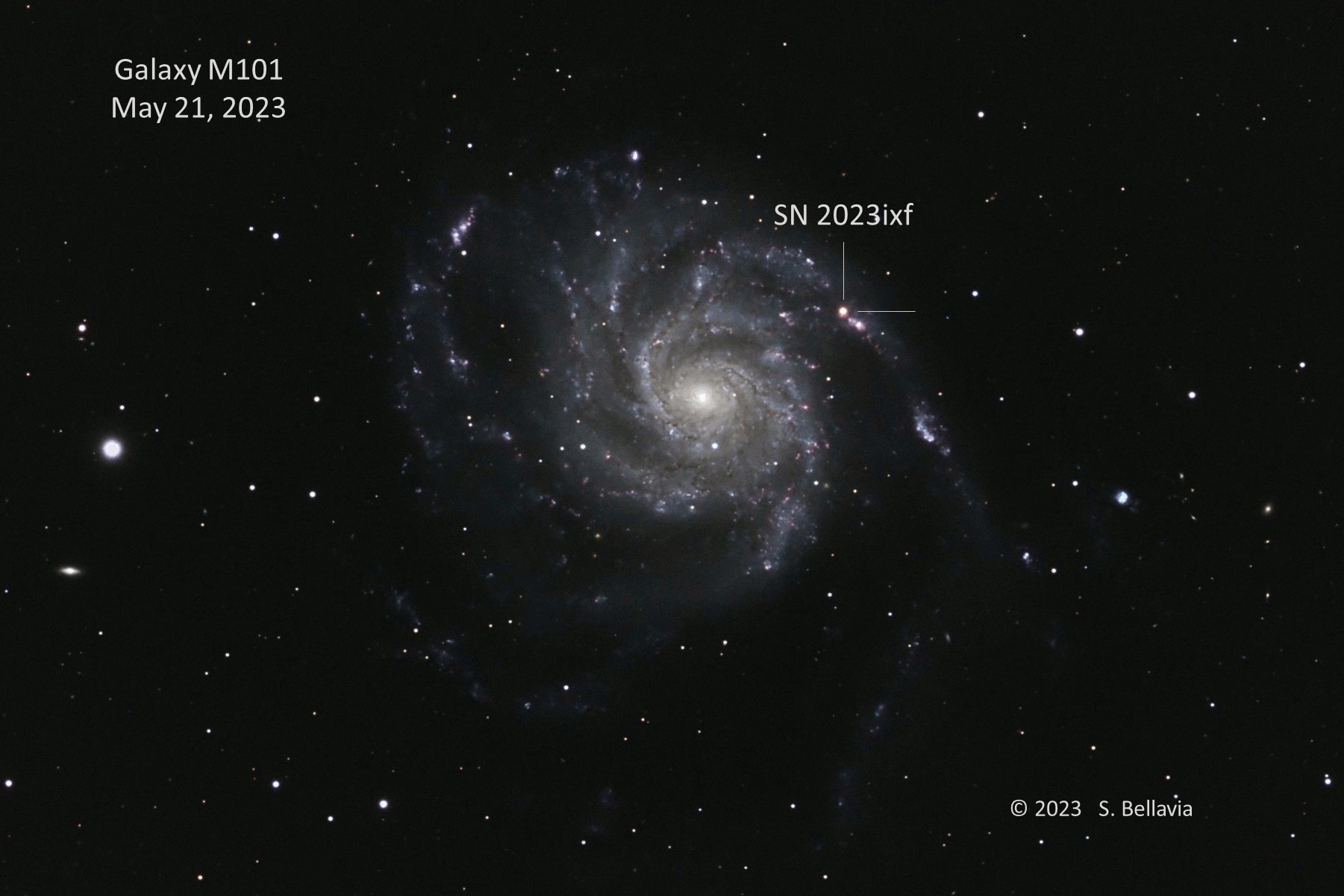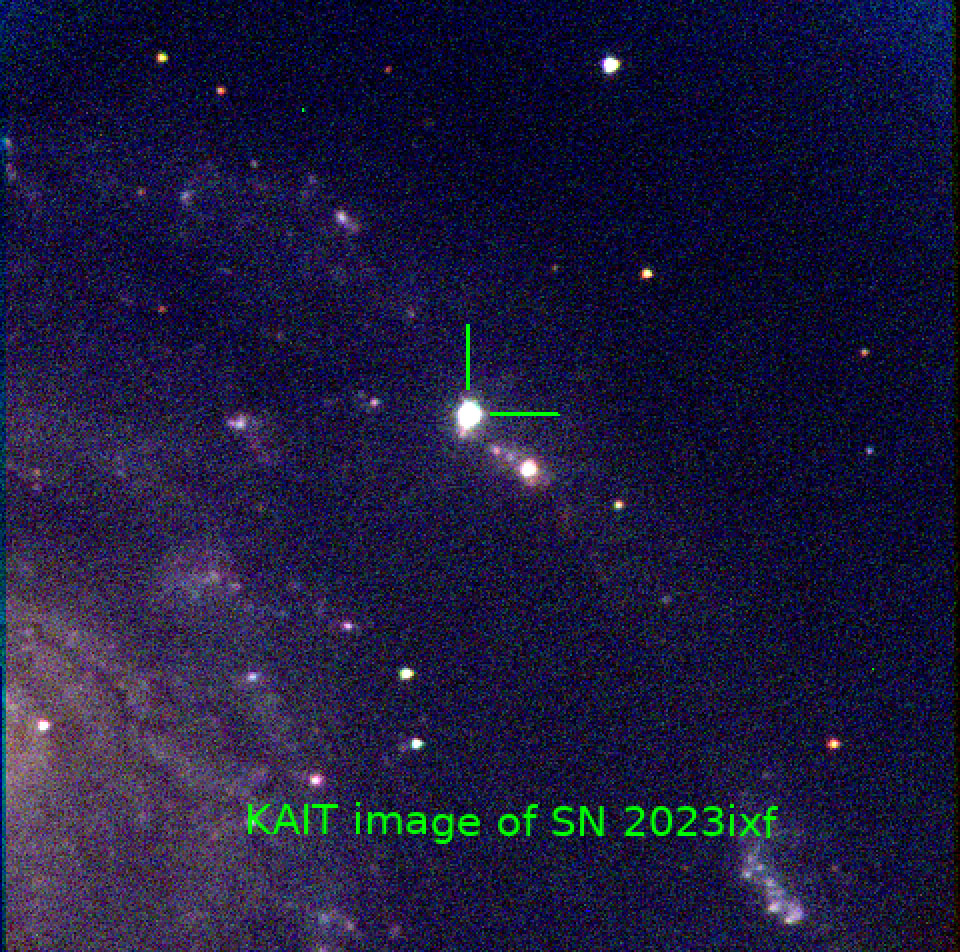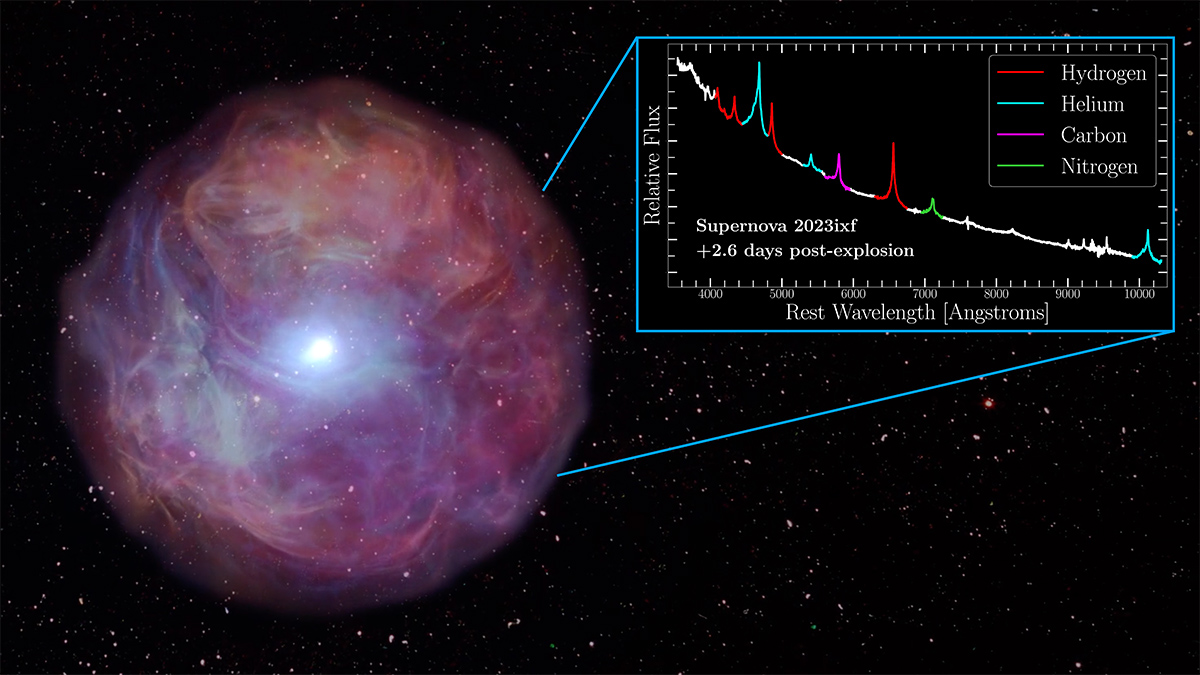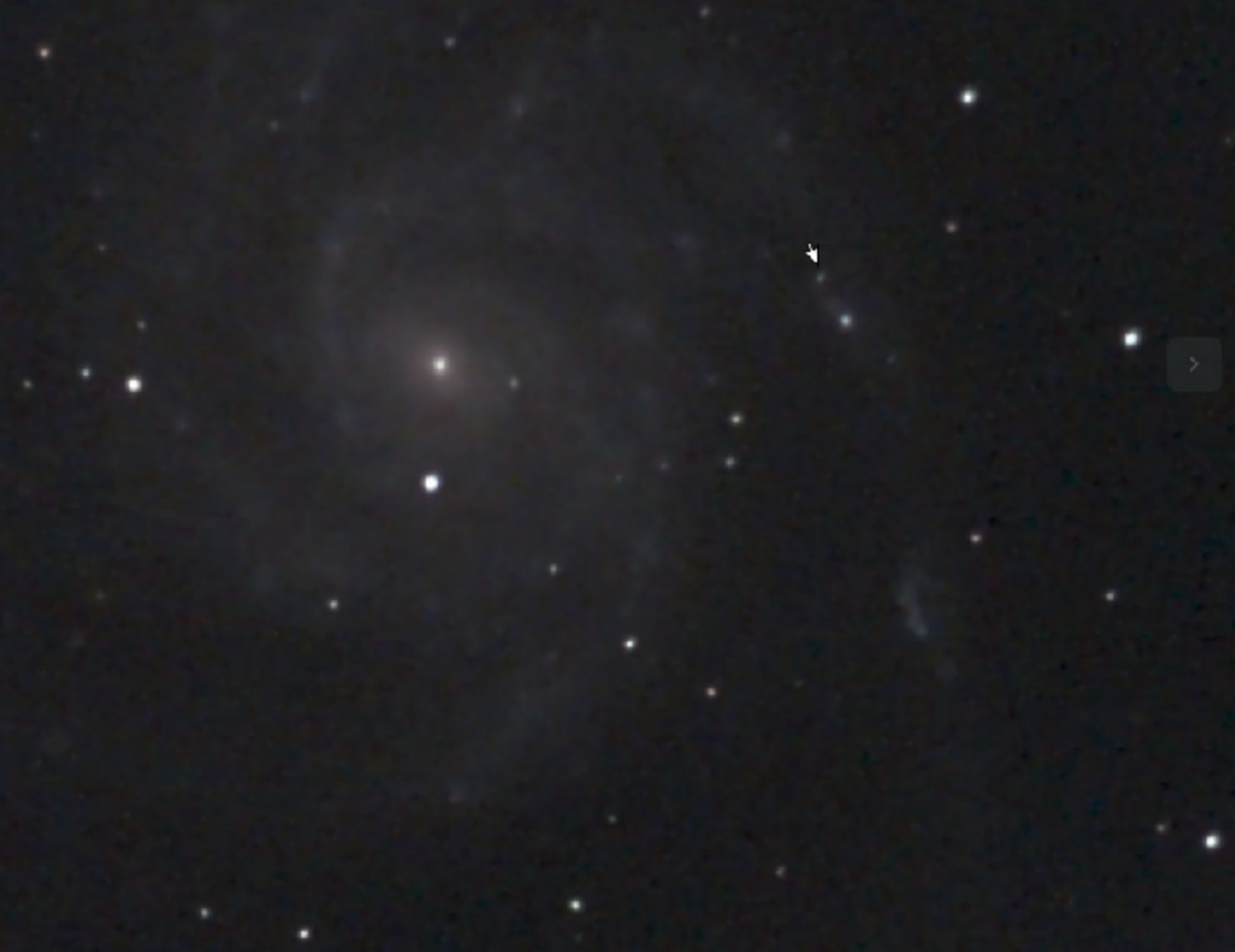Closest Supernova in a Decade Reveals How Exploding Stars Evolve

Alex Filippenko is the kind of guy who brings a telescope to a party. True to form, at a soiree on May 18 this year, he wowed his hosts with images of star clusters and colorful galaxies — including the dramatic spiral Pinwheel Galaxy — and snapped telescopic photos of each.
Only late the next afternoon did he learn that a bright supernova had just been discovered in the Pinwheel Galaxy. Lo and behold, he'd also captured it, at 11 p.m. the night before — 11 and a half hours before the explosion's discovery on May 19 by amateur astronomer Koichi Itagaki in Japan.
Filippenko, a professor of astronomy at the University of California, Berkeley, graduate student Sergiy Vasylyev and postdoctoral fellow Yi Yang threw out their planned observations at the UC’s Lick Observatory on Mount Hamilton a few hours later to focus on the exploding star, which had been dubbed SN 2023ixf. They and hundreds of other astronomers were eager to observe the nearest supernova since 2014, a mere 21 million light years from Earth.
These observations were the earliest-ever measurements of polarized light from a supernova, showing more clearly the evolving shape of a stellar explosion. The polarization of light from distant sources like supernovae provides the best information on the geometry of the object emitting the light, even for events that cannot be spatially resolved.
"Some stars prior to exploding go through undulations — fitful behavior that gently ejects some of the material — so that when the supernova explodes, either the shock wave or the ultraviolet radiation causes the stuff to glow," Filippenko said. "The cool thing about the spectropolarimetry is that we get some indication of the shape and extent of the circumstellar material."
The spectropolarimetry data told a story in line with current scenarios for the final years of a red supergiant star about 10 to 20 times more massive than our sun: Energy from the explosion lit up clouds of gas that the star shed over the previous few years; the ejecta then punched through this gas, initially perpendicular to the bulk of the circumstellar material; and finally, the ejecta engulfed the surrounding gas and evolved into a rapidly expanding, but symmetric, cloud of debris.
The explosion, a Type II supernova resulting from the collapse of the iron core of a massive star, presumably left behind a dense neutron star or a black hole. Such supernovae are used as calibratable candles to measure the distances to distant galaxies and map the cosmos.
Another group of astronomers led by Ryan Chornock, a UC Berkeley adjunct associate professor of astronomy, gathered spectroscopic data using the same telescope at Lick Observatory. Graduate student Wynn Jacobson-Galán and professor Raffaella Margutti analyzed the data to reconstruct the pre- and post-explosion history of the star, and found evidence that it had shed gas for the previous three to six years before collapsing and exploding. The amount of gas shed or ejected before the explosion could have been 5% of its total mass — enough to create a dense cloud of material through which the supernova ejecta had to plow.
"I think this supernova is going to make a lot of us think in much more detail about the subtleties of the whole population of red supergiants that lose a lot of material before explosion and challenge our assumptions about mass loss," Jacobson-Galán said. "This was a perfect laboratory to understand in more detail the geometry of these explosions and the geometry of mass loss, something we already felt ignorant about."
The improved understanding of how Type II supernovae evolve could help refine their use as distance measures in the expanding universe, Vasylyev said.
The two papers describing these observations have been accepted for publication in The Astrophysical Journal Letters. Margutti and Chornock are co-authors of both papers.
One of the most studied supernovae to date
In the more than three months since the supernova's light reached Earth, perhaps three dozen papers have been submitted or published about it, with more to come as the light from the explosion continues to arrive and the observations of a variety of telescopes are analyzed.

WeiKang Zheng and Alex Filippenko/UC Berkeley
"In the world of Type II supernovae, it's very rare to have basically every wavelength detected, from hard X-rays to soft X-rays to ultraviolet. to optical, near-infrared, radio, millimeter. So it's really a rare and unique opportunity," said Margutti, a Berkeley professor of physics and of astronomy. "These papers are the beginning of a story, the first chapter. Now we are writing the other chapters of the story of that star."
"The big-picture question here is we want to connect how a star lives with how a star dies," Chornock said. "Given the proximity of this event, it will allow us to challenge the simplifying assumptions that we have to make in most of the other supernovae we study. We have such a wealth of detail that we're going to have to figure out how to fit it all together to understand this particular object, and then that will inform our understanding of the broader universe."
Lick Observatory's telescopes on top of Mount Hamilton near San Jose were critical to the astronomers' efforts to assemble a complete picture of the supernova. The Kast spectrograph on the Shane 120-inch telescope is able to switch quickly from a normal spectrometer to a spectropolarimeter, which allowed Vasylyev and Filippenko to obtain measurements of both the spectrum and its polarization. The group led by Jacobson-Galán, Chornock and Margutti employed both the Kast spectrograph and the photometer on the Nickel 40-inch telescope, with photometry (brightness measurements) also from the Pan-STARRS telescope in Hawaii through the Young Supernova Experiment collaboration.
The polarization of light emitted by an object — that is, the orientation of the electric field of the electromagnetic wave — carries information about the shape of the object. Light from a spherically symmetric cloud, for example, would be unpolarized because the electric fields symmetrically cancel. Light from an elongated object, however, would produce a nonzero polarization.
While polarimetry measurements of supernovae have been going on for more than three decades, few are close enough — and thus bright enough — for such measurements. And no other supernova has been observed as early as 1.4 days after the explosion, as with SN 2023ixf.
The observations yielded some surprises.
"The most exciting thing is that this supernova shows a very high continuum polarization, nearly 1%, at early times," Vasylyev said. "That sounds like a small number, but it's actually a huge deviation from spherical symmetry."

Sergiy Vasylyev, Yi Yang and Alex Filippenko/UC Berkeley
Based on the changing intensity and direction of polarization, the researchers were able to identify three distinct phases in the evolution of the exploding star. Between one and three days after the explosion, the light was dominated by emission from the circumstellar medium, perhaps a disk of material or lopsided blob of gas shed earlier by the star. This was due to ionization of the surrounding gas by ultraviolet and X-ray light from the explosion and by stellar material plowing through the gas, so-called shock ionization.
"Early on, we're saying that most of the light that we're seeing is from some kind of non-spherical circumstellar medium that is confined to somewhere around 30 A.U.," Yang said. An astronomical unit (AU), the average distance between Earth and our sun, is 93 million miles.
At 3.5 days, the polarization quickly dropped by half, and then a day later shifted by nearly 70 degrees, implying an abrupt change in the geometry of the explosion. They interpret this moment, 4.6 days after explosion, as the time when the ejecta from the exploding star broke out from the dense circumstellar material.
"Essentially, it engulfs the circumstellar material, and you get this peanut-shaped geometry," Vasylyev said. "The intuition there is that the material in the equatorial plane is denser, and the ejecta get slowed down, and the path of least resistance will be toward the axis where there's less circumstellar material. That's why you get this peanut shape aligned with the preferential axis through which it explodes."
The polarization remained unchanged between days 5 and 14 after the explosion, implying that the expanding ejecta had overwhelmed the densest region of surrounding gas, allowing emission from the ejecta to dominate over light from shock ionization.
Shock ionization
The spectroscopic evolution roughly agreed with this scenario, Jacobson-Galán said. He and his team saw emissions from the gas surrounding the star about a day after the explosion, likely produced as the ejecta slammed into the circumstellar medium and produced ionizing radiation that caused the surrounding gas to emit light. Spectroscopic measurements of the light from this shock ionization showed emission lines from hydrogen, helium, carbon and nitrogen, which is typical of core-collapse supernovae.

Wynn Jacobson-Galán, Ryan Chornock, Raffaella Margutti/UC Berkeley
The emissions produced by shock ionization continued for about eight days, after which it decreased, indicating that the shock wave had moved into a less dense area of space with little gas to ionize and reemit, similar to what Vasylyev and Filippenko observed.
Margutti noted that other astronomers have looked at archival images of the Pinwheel Galaxy and found several occasions when the progenitor star brightened in the years before the explosion, suggesting that the red supergiant repeatedly sloughed off gas. This is consistent with her group's observations of ejecta from the explosion plowing through this gas, though they estimate a density about 1,000 times less than implied by the pre-explosion undulations.
Analysis of other observations, including X-ray measurements, could resolve this issue.
"This is a very special situation where we know what the progenitor was doing before because we saw it slowly oscillating, and we have all the probes in place to try to reconstruct the geometry of the circumstellar medium," she said. "And we know for a fact that it cannot be spherical. By putting together the radiant X-rays with what Wynn found and what Sergiy and Alex are finding, then we will be able to have a complete picture of the explosion."
The astronomers acknowledged the help of numerous researchers and students who gave up their observing time at Lick to allow the teams to focus on SN 2023ixf, and the observational assistance of Thomas Brink, an associate specialist in astronomy at UC Berkeley.

Filippenko captured his early photo of SN 2023ixf with a Unistellar eVscope, which has become popular among amateurs because the telescope subtracts background light and thus allows nighttime viewing in areas like cities, with lots of light pollution. He and 123 other astronomers — mostly amateurs — using Unistellar telescopes recently published their early observations of the supernova.
“This fortuitous observation, obtained while conducting public outreach in astronomy, shows that the star exploded considerably earlier than when Itagaki discovered it,” he said, jokingly adding, “I should have immediately examined my data!”
Filippenko's research was supported by Steven Nelson, the Christopher R. Redlich Fund, Landon Noll, Sunil Nagaraj, Sandy Otellini, Gary and Cynthia Bengier, Clark and Sharon Winslow, Sanford Robertson, Alan Eustace, Frank and Kathleen Wood, and numerous other donors. The work led by Chornock and Margutti was supported by the National Science Foundation, the Heising-Simons Foundation and Marc and Cristina Bensadoun.
